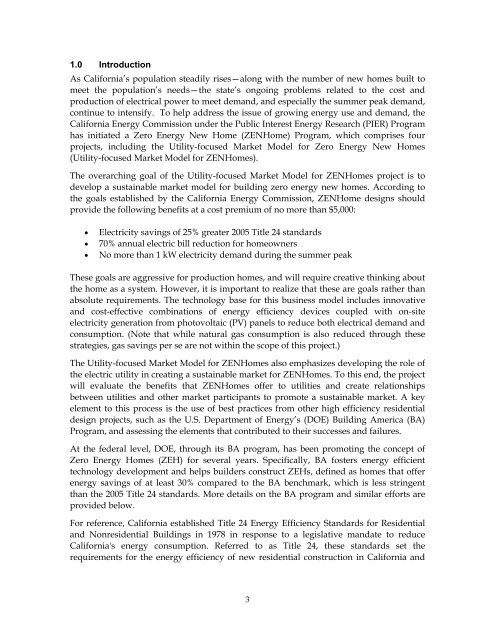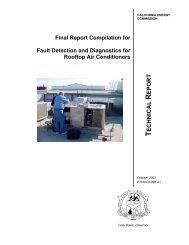design process study for the demonstration homes - Architectural ...
design process study for the demonstration homes - Architectural ...
design process study for the demonstration homes - Architectural ...
You also want an ePaper? Increase the reach of your titles
YUMPU automatically turns print PDFs into web optimized ePapers that Google loves.
1.0 Introduction<br />
As Cali<strong>for</strong>nia’s population steadily rises—along with <strong>the</strong> number of new <strong>homes</strong> built to<br />
meet <strong>the</strong> population’s needs—<strong>the</strong> state’s ongoing problems related to <strong>the</strong> cost and<br />
production of electrical power to meet demand, and especially <strong>the</strong> summer peak demand,<br />
continue to intensify. To help address <strong>the</strong> issue of growing energy use and demand, <strong>the</strong><br />
Cali<strong>for</strong>nia Energy Commission under <strong>the</strong> Public Interest Energy Research (PIER) Program<br />
has initiated a Zero Energy New Home (ZENHome) Program, which comprises four<br />
projects, including <strong>the</strong> Utility-focused Market Model <strong>for</strong> Zero Energy New Homes<br />
(Utility-focused Market Model <strong>for</strong> ZENHomes).<br />
The overarching goal of <strong>the</strong> Utility-focused Market Model <strong>for</strong> ZENHomes project is to<br />
develop a sustainable market model <strong>for</strong> building zero energy new <strong>homes</strong>. According to<br />
<strong>the</strong> goals established by <strong>the</strong> Cali<strong>for</strong>nia Energy Commission, ZENHome <strong>design</strong>s should<br />
provide <strong>the</strong> following benefits at a cost premium of no more than $5,000:<br />
• Electricity savings of 25% greater 2005 Title 24 standards<br />
• 70% annual electric bill reduction <strong>for</strong> homeowners<br />
• No more than 1 kW electricity demand during <strong>the</strong> summer peak<br />
These goals are aggressive <strong>for</strong> production <strong>homes</strong>, and will require creative thinking about<br />
<strong>the</strong> home as a system. However, it is important to realize that <strong>the</strong>se are goals ra<strong>the</strong>r than<br />
absolute requirements. The technology base <strong>for</strong> this business model includes innovative<br />
and cost-effective combinations of energy efficiency devices coupled with on-site<br />
electricity generation from photovoltaic (PV) panels to reduce both electrical demand and<br />
consumption. (Note that while natural gas consumption is also reduced through <strong>the</strong>se<br />
strategies, gas savings per se are not within <strong>the</strong> scope of this project.)<br />
The Utility-focused Market Model <strong>for</strong> ZENHomes also emphasizes developing <strong>the</strong> role of<br />
<strong>the</strong> electric utility in creating a sustainable market <strong>for</strong> ZENHomes. To this end, <strong>the</strong> project<br />
will evaluate <strong>the</strong> benefits that ZENHomes offer to utilities and create relationships<br />
between utilities and o<strong>the</strong>r market participants to promote a sustainable market. A key<br />
element to this <strong>process</strong> is <strong>the</strong> use of best practices from o<strong>the</strong>r high efficiency residential<br />
<strong>design</strong> projects, such as <strong>the</strong> U.S. Department of Energy’s (DOE) Building America (BA)<br />
Program, and assessing <strong>the</strong> elements that contributed to <strong>the</strong>ir successes and failures.<br />
At <strong>the</strong> federal level, DOE, through its BA program, has been promoting <strong>the</strong> concept of<br />
Zero Energy Homes (ZEH) <strong>for</strong> several years. Specifically, BA fosters energy efficient<br />
technology development and helps builders construct ZEHs, defined as <strong>homes</strong> that offer<br />
energy savings of at least 30% compared to <strong>the</strong> BA benchmark, which is less stringent<br />
than <strong>the</strong> 2005 Title 24 standards. More details on <strong>the</strong> BA program and similar ef<strong>for</strong>ts are<br />
provided below.<br />
For reference, Cali<strong>for</strong>nia established Title 24 Energy Efficiency Standards <strong>for</strong> Residential<br />
and Nonresidential Buildings in 1978 in response to a legislative mandate to reduce<br />
Cali<strong>for</strong>nia's energy consumption. Referred to as Title 24, <strong>the</strong>se standards set <strong>the</strong><br />
requirements <strong>for</strong> <strong>the</strong> energy efficiency of new residential construction in Cali<strong>for</strong>nia and<br />
3








